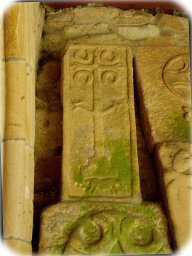A Welcome At St Helen's Church - Darley Dale
This is a copy of an article published in The Peak Advertiser,
the Peak District's local free newspaper on 11th August 2008,
reproduced by kind permission of its author, Julie Bunting.
A WELCOME AT ST HELEN'S CHURCH, DARLEY DALE
A Wicked Knight Contemporary with the fabric of the church are monuments to those who could afford to be buried, with some style, inside its walls. Landed gentry and lords of the manor lie here, the earliest effigy being the handsome Sir John de Darley reposing in chain mail and surcoat. The de Darleys of the Old Hall held the manor of Darley over a long period and Sir John was Governor of Peak Castle in 1309. Tradition has it that ‘he died of his heart coming out of his mouth whilst hunting on the Sabbath day’. For centuries the entombed remains of the wicked knight - who indeed holds his heart in his hands - lay half inside and half outside the south wall of the church, a final reproof for the irreverent behaviour that almost saw him excommunicated. The Columbells of Darley Nether Hall have two badly worn 16th-century alabaster memorial slabs. A slightly later example commemorates a daughter of the Wednesley family, for 400 years lords of the manor of Wensley. Finely detailed alabaster slabs of 1513 and 1550 depict two generations of the Rollesleys, each with Indian-style files of their 12 children. The family held the ancient manor of Little Rowsley. The Millwards of Snitterton are represented in an ornate 17th-century mural monument. A fine 14/15th-century stone screen encloses the Whitworth family pew, overlooked by a window showing figs, pomegranates and other exotic fruits as grown in Whitworth's conservatory at Stancliffe Hall. Sir Joseph and Lady Whitworth are buried side by side in the churchyard. Fragments of medieval glass survive in the north window whilst St Chad's Chapel or Columbell Quire is illuminated by the glowing colours of a Burne-Jones window representing the Song of Solomon. The Churchyard Darley parish registers, now stored at Derbyshire Record Office, contain fascinating references to the more humble parishioners of times past. Whereas Thomas Frith, who died in 1648 at the age of 106, is one of a respectable number of recorded centenarians, dismal entries of the 1550s tell how ‘ye sweatinge sickness’ claimed 9 lives in 6 days; plague and smallpox struck intermittently; men and women perished in wintry storms on the moors and many men died in lead mining accidents. Vagrants who died in the parish include a ‘poor, wandering’ 10-year old Lancashire girl. A surprising number of parishioners drowned, some by suicide, in the regularly swollen Derwent. More than one man fell to his death, accidentally or otherwise, from the enormous churchyard yew. A quiet walk amongst the centuries-old graves passes a weaver's table tomb, carved with his shuttles, wheels and handloom. Look too for a number of medieval bases serving second use beneath Victorian slabs. © Julie Bunting |
||||
